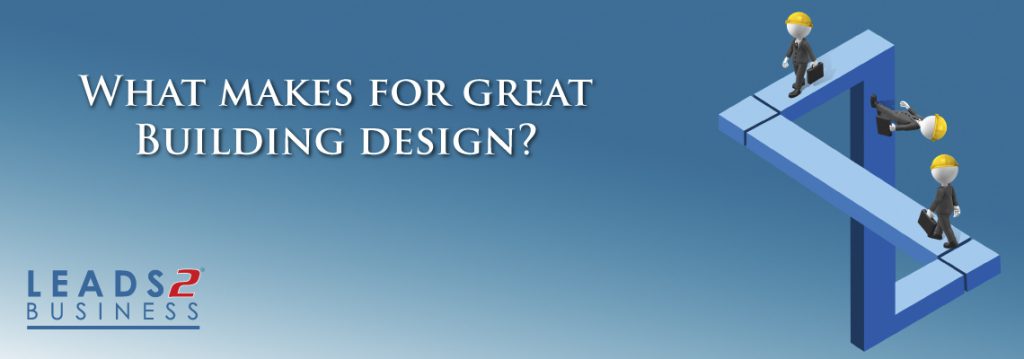What makes for great building design?

What makes for great building design… There is a unique mind inside the head of an architect that is magically able to juggle numbers, lines and angles, along with creative possibilities that most of us cannot fathom. Architects have a strong understanding of all building disciplines, including structural, electrical and mechanical.
This takes Smarts. And while simply being smart does not make you a good architect, it does give you a good foundation. You must be able to determine the necessary calculations to make buildings work, understand the properties of the materials you are working with, and create safe and sound structures from start to finish.
A good design should consist of the following characteristics:
1. Sustainable
Sustainable construction considers the complete lifecycle of a building, from the choice of initial materials to demolition and recycling and refers to the use of environmentally preferable practices and solutions in each of the phases.
2. Accessible
What is a good design if it’s only available to some? The concept focuses on enabling people with disabilities, or special needs, or enabling access through the use of assistive technology.
3. Functional
This should be the simplest attribute of good design, but it is often the hardest to achieve.
4. Well Made
Architects don’t make anything. The architects say how well a building is built is limited to a set of instructions they provide. In the end, people that actually build it have little to no actual interaction with the architect. This means the instructions better be good, and just as important, easy to understand.
5. Emotionally Resonant
Every design should be an attempt to stir the senses.
6. Enduring
Buildings need both structural and aesthetic longevity. It’s important to innovate, but you don’t want a design that looks outdated before that last coat of paint dries. The time frame for enduring is uncertain.
7. Socially Beneficial
Whether you like it or not, all architecture is public architecture. Architects have a responsibility to look both within and beyond the walls of buildings to see what they can do to help.
8. Beautiful
Beauty is subjective, right?
9. Ergonomic
Buildings must relate to the scale of the people that inhabit them. Often this idea is lost in the array of 3D computer modelling technologies that architects use these days. Stop and take a step back. Put a person in that model. Even if they’re digital.
10. Affordable
Creating affordable architecture is more difficult. It involves entrepreneurship on the part of the architect. An upfront investment to invent an affordable solution that the masses can afford.
Being an architect is more than just drawing and building. It involves social skills, a knowledge of engineering, math, science, physics and several related topics; dedication and drive; and, most important, the ability to design.
If you are interested in becoming one of our subscribers, please visit our website.
To view notes with screenshots on how to use our website, please visit our Wiki site.
To view more articles, please visit our blog.
About Nadine Vermeulen
I started working at Leads 2 Business in October 2014 in the Leads 2 Quotes Department. I managed all the Daily Tender Bill Requests and followed up on BoQ's for our Daily Tender Subscribers. In 2017, I was promoted to L2Q Assistant and now work with Bill of Quantities for Contractors. 🙂
- Web |
- More Posts(14)








Mthulisi Msimang
Interesting article. But I believe item 4 is inaccurate, in its claim that people who build have no interaction with the architect. This is only true in some instances. Yes, architects do not make anything per se, but their involvement generally does not end with the issue of instructions/ drawings. Architects are usually intimately involved during construction, which provides them not only the opportunity to guide, refine and clarify these instruction, but allows them to issue further corrective instructions should the need arise.
Eldary Carpenter
Hi Mthulisi, thank you for your feedback.